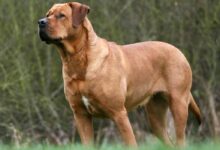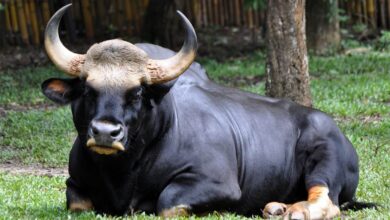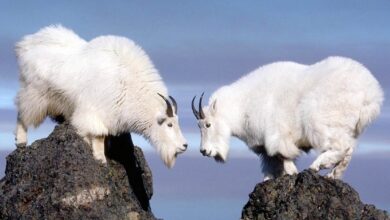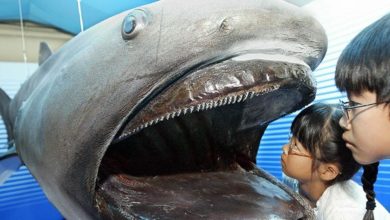Oncilla (Leopardus tigrinus) – a living decoration of South American forests
Oncilla, northern tiger cat, little spotted cat, tigrillo
One of the most beautiful cats in the New World is certainly the tiger oncilla. It was once one of the most common small predators in South America and is still quite numerous today, despite intensive hunting and the destruction of natural habitats. There are also many indications that this tiny predator will do well in the future.
Unlike other species of wild cats living in the forests of America, the oncilla has been captured many times; it also turned out that – again unlike other predators of this continent – it tolerates captivity well. In this way, he is one of the few small cats of the New World that has been reasonably well known and studied. It has many names – it is also known as the northern tiger cat and little spotted cat. In Spanish-speaking countries, it is known as “Tigrillo”.

Classification
- Kingdom: Animalia
- Phylum: Chordata
- Class: Mammalia
- Order: Carnivora
- Suborder: Feliformia
- Family: Felidae
- Subfamily: Felinae
- Genus: Leopardus
- Species: Leopardus tigrinus
- Names: Oncilla, northern tiger cat, little spotted cat, tigrillo

Occurrence
The oncilla is associated with the Amazon. In fact, its range is very wide – from Costa Rica and Panama to central Brazil. It lives in various types of forests. Its habitat is both misty forests in the northern Andes, where it is found at an altitude of up to 3,000 m (9,800 ft). Its appearance was recorded at a height of 4,800 m (15,700 ft), as well as in subtropical forests. It also ventures into areas covered with dry deciduous forests and shrubs in semi-deserts.
Scientists have observed differences in the appearance of these cats throughout their range and have distinguished four subspecies. One of them (Leopardus tigrinus guttulus) is sometimes considered a separate species – especially since it can no longer interbreed with representatives of other subspecies.

Characteristic
Appearance
Oncilla resembles an ocelot and a margay, but is smaller and more slender than them. Its mouth is narrow and its ears are rounded. It is one of the smallest wild cats in the world, weighing only 1.5-3 kg (3.3 – 6.6 lb). It grows up to 59 cm (23 in) long, to which a tail of 42 cm (16.5 in) should be added. Dimensionally, it is larger than the average domestic cat, but much lighter.
The fur of the oncilla is very dense and smooth, usually light brown in color, although sometimes darker. The underside of the body is light.. Numerous black or dark brown spots are visible on the body, which on the back and sides have the shape of irregular rosettes with a bright interior. On the underside of the body, the spots are smaller. They also appear on the legs, gradually reducing their size towards the toes. There are dark rings on the tail. The ears are black, with a single white spot on each.
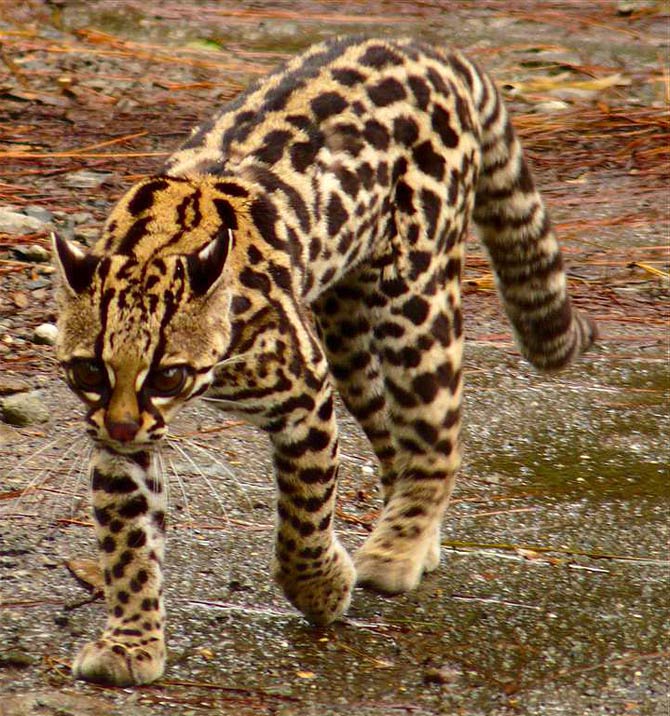
Lifestyle
The coloration of the oncilla may seem bright, but it must be remembered that this cat lives in forests. Under such conditions, light penetrates the tree canopy with difficulty, creating a speckled pattern with the shadows of the leaves against a bright background – in such lighting it is very difficult to see oncilla. The northern tiger cat is primarily a terrestrial predator, but if necessary it can perfectly climb trees, although if it can, it avoids it.
The oncilla, like all cats, is a strict carnivore. The most important item on his menu are rodents and other small mammals. In arid regions, most of its food is lizards. It also eats invertebrates and frogs. It hunts much like a domestic cat: It closely tracks its prey from a distance, and when it gets close enough, it suddenly jumps and kills it.
The oncilla is essentially nocturnal – at least when it lives in a dense forest. However, animals living in arid areas, including semi-arid areas, switch to day mode. It has to do with the fact that only during the day they can hunt lizards – their basic food in these conditions.
Communication between northern tiger cats is not much different from that of domestic cats. Young ones often purr, while older ones make sounds similar to a short gurgling when they come closer to each other.

Reproduction
The oestrus of oncillas lasts 3-9 days (this period shortens with age). After 74-76 days of pregnancy, the female gives birth to 1-3 kittens. They only open their eyes after 17 days – longer than any other similar-sized cat. Contrary to other cats, where the incisors erupt first, in oncillas all teeth appear almost simultaneously, around 21 days of age. However, kittens do not eat solid food until they are 38-56 days old – again much more than cats of similar size. They stop drinking milk at around 3 months of age.
Oncillas reach sexual maturity around 2-2.5 years of age. In the wild, they live up to 11 years. They live longer in captivity – often up to 17 years.

Oncilla and humans
As the owner of soft and beautifully colored, and therefore extremely expensive fur, the oncilla often fell prey to hunting. The report for the years 1972-1982 showed that this oncilla was the fourth most fished among small cats in the world. At that time, as many as 85,000 skins were exported from Paraguay itself. The significant decline in numbers has forced the countries where the cat lives to restrict trade. However, hunting for this cat is still allowed in Ecuador, Nicaragua and Peru.
Another threat to oncilla is environmental damage. The oncilla prefers areas densely covered with trees, the area of which is systematically decreasing. The greatest impact on this is the cutting of trees for coffee plantations in cloud forests.
In order to reduce the scope of hunting and poaching, while realizing the demand for natural fur, Brazil started a program of breeding several small cats, including the oncilla. In such farms, these cats live in conditions that are as close to natural as possible. Despite some controversy and protests by organizations opposing the breeding of animals for fur, this program has significantly reduced the number of hunts for wild cats.
Oncillas are easily tamed and their fear of humans quickly fades. Therefore, in the Americas, they are sometimes bred as pets. Their behavior does not differ much from that of domestic cats. Unfortunately, for unknown reasons, a large number of deaths of newborn kittens in captivity is recorded.
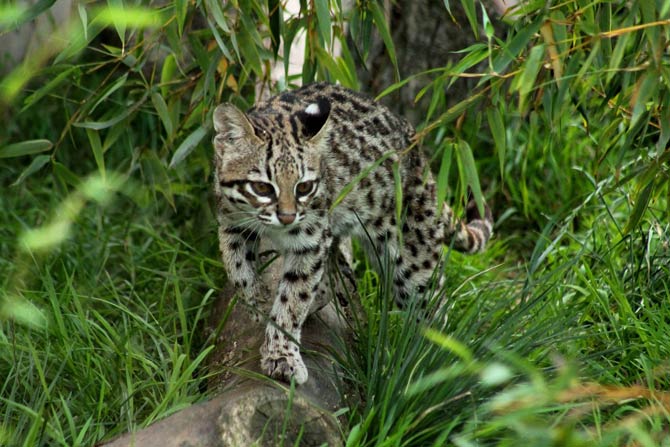
The future of oncilla
The northern tiger cat – due to the constant destruction of habitats – was classified by the IUCN as “vulnerable to extinction”. Fortunately, it shows very high adaptability. As the existing habitats are destroyed, these cats are more and more often seen in exposed areas, e.g. in dry forests and thickets. They can also switch to a daily lifestyle, which greatly increases their chances of surviving in the wild.
The researchers noted that in the southern regions of its range, the oncilla crosses with the closely related Geoffroy’s cat (Leopardus geoffroyi). Such crossbreeds are fertile. This is a natural process and it is not known how this will affect the species. It is now considered that the scope of this phenomenon is too limited to pose a risk to the oncillas.
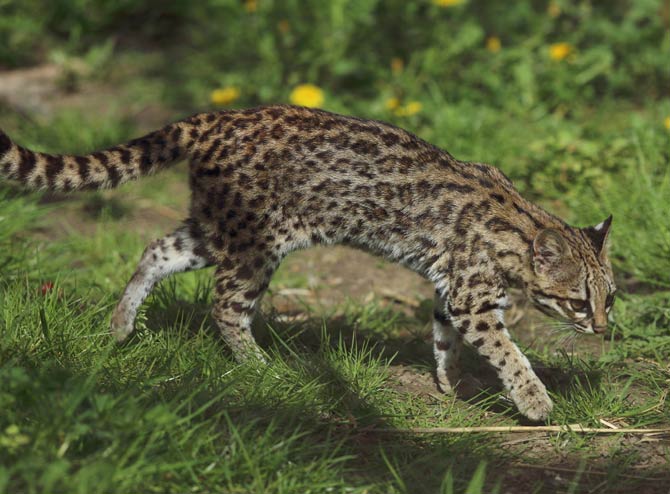
Detailed data / dimensions
Tiger ocelot, tiger cat, oncilla (Leopardus tigrinus / Felis tigrinus)
- Body length: 38-59 cm (15 – 23 in)
- The length of the tail: 20-42 cm (7.9 – 16.5 in)
- Body weight: 1.5-3 kg (3.3 – 6.6 lb)
- Lifespan: 11 years in the wild, up to 17 years in captivity
Interesting facts
- In all languages, this cat is nicknamed “tiger” (eg. “northern tiger cat” in English), even though tigers have stripes on their bodies and oncilla have spots.
- Melanistic oncillas can be found in the densest regions of rainforests.

Recommended
- Asian golden cat
- Bay cat
- Lion vs tiger
- Tsavo lions
- Barbary lion
- Siberian tiger
- Bengal tiger
- Sumatran tiger
- Indochinese tiger
- Malayan tiger
- Tigers
- White tigers
- Lions
- White lions
- Liger
- Animal fights
- Big cats
- Black panther
- Leopard
- Snow leopard
- African Lion
- Fastest animals
- Fastest birds





